When several Core Algorithm Updates were enforced by Google last year, they proved to be a game-changer for a large number of websites. While some of the businesses benefited massively from these updates, whereas most of them lost their rankings on Google. The urge to be in the top 10 positions of Google or finding a valuable place in Google’s Featured Snippets is what targeted by the business-oriented websites. And, the implementation of such updates rolled out by the search engine giant helps them to attain their targeted objectives with minimalistic efforts in the long run.
With the commencement of the year 2020, Google rolled out another Core Algorithm Update called “January 2020 Core Update” on 13th January with a wider perspective. The recent technological update is a challenge for the webmasters and SEOs as it may cause significant SERP fluctuations and change the organic ranking positions of websites. The rolling out of this update aims at centralizing the user intent and refining the search quality by providing better search results to the users.
The Google Broad Core Algorithm Update 2020 is quite extensive in terms of the aspects it covers. A dig into the details of this update will certainly help you tackle the challenges and improvise your rankings on Google. Let’s have a read –
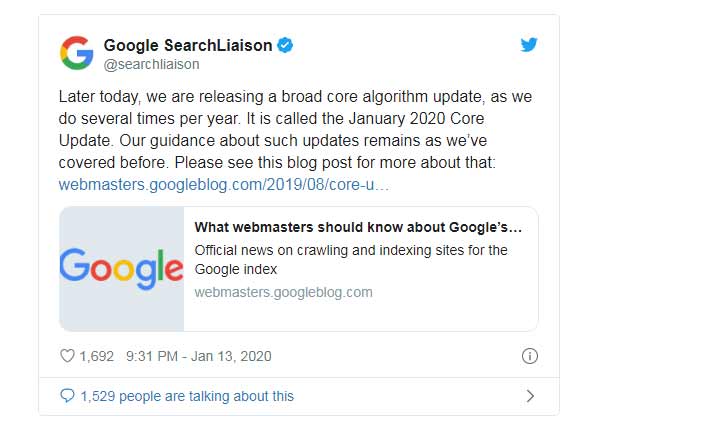
What is a Google Broad Core Update?
A Google Broad Core Update is an algorithm update that can impact the search visibility of the majority of websites. This update is a complete improvisation of the overall Google algorithm aims to understand search queries of the users and websites in a better way. These developments will improve the accuracy of the Google in matching search queries of the users with the search results to impart better user experience and satisfaction. Just like other algorithm updates, Google reassesses the SERP Ranking of the websites on the basis of the “Expertise, Authoritativeness, Trustworthiness (E-A-T)” guidelines.
Highlights of the update:
- The broad core update may lead to dropping keywords, loss of organic traffic, loss of rich snippets, and drop in the ranking position.
- The update is more content-oriented and focuses on the quality of the content.
- There is no fix for websites that were affected by Google update, but to improve the content quality.
- Follow the guidelines of Expertise, Authority, and Trustworthiness (E.A.T.)
Checklist to Identify Impacts of Google Core Update
Have you noticed a sudden and significant drop in the Google rankings after the implementation of January 2020 Google core algorithm update? Are you blaming the latest algorithm update by Google for it? Google’s algorithmic updates are not always the reasons behind the organic traffic loss. To have a deeper understanding of the underlying problem, there are few things you should look into:
- Are there any major changes done on your website?
- Are your pages displaying properly?
- Is it a specific page or the complete website that lost the traffic?
- Is the traffic loss limited to new visitors or the previous ones?
Asking these questions to oneself not just gives you an insight into the reasons behind your lost Google ranking, but also in diagnosing these issues. Usually, after doing a detailed investigation of your data and the overall website after being hit by the latest core algorithm update, these can be the reasons for the damage caused to the website and its ranking –
- Broken landing pages
- Poor quality content
- Major changes done to the website
- Changing placements o advertisements, etc.
If the drop in the traffic of the site is not due to these reasons, then the chances are higher that you can be a victim of a Google core update. In such a case, the only way out is to create high-quality content for the users.
Google advice on quality of content
Content and quality questions
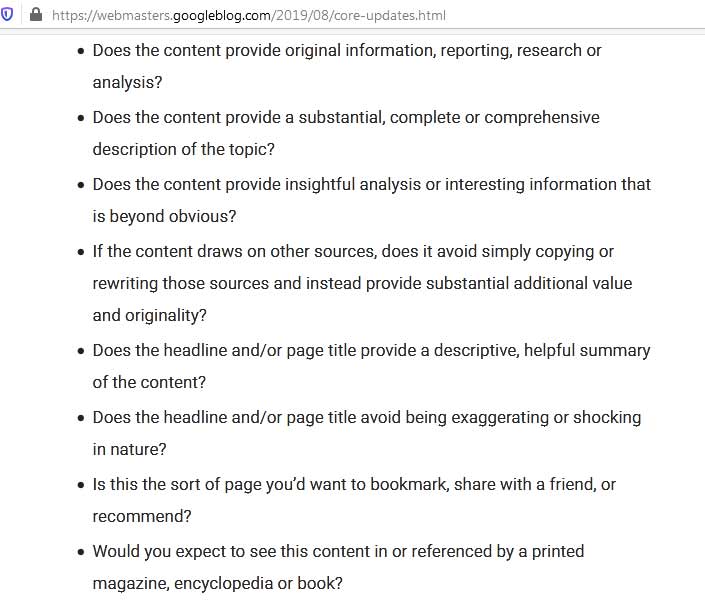
- Does the content provide original information, reporting, research or analysis?
- Does the content provide a substantial, complete or comprehensive description of the topic?
- Does the content provide insightful analysis or interesting information that is beyond obvious?
- If the content draws on other sources, does it avoid simply copying or rewriting those sources and instead provide substantial additional value and originality?
- Does the headline and/or page title provide a descriptive, helpful summary of the content?
- Does the headline and/or page title avoid being exaggerating or shocking in nature?
- Is this the sort of page you’d want to bookmark, share with a friend, or recommend?
- Would you expect to see this content in or referenced by a printed magazine, encyclopedia or book?
Expertise questions
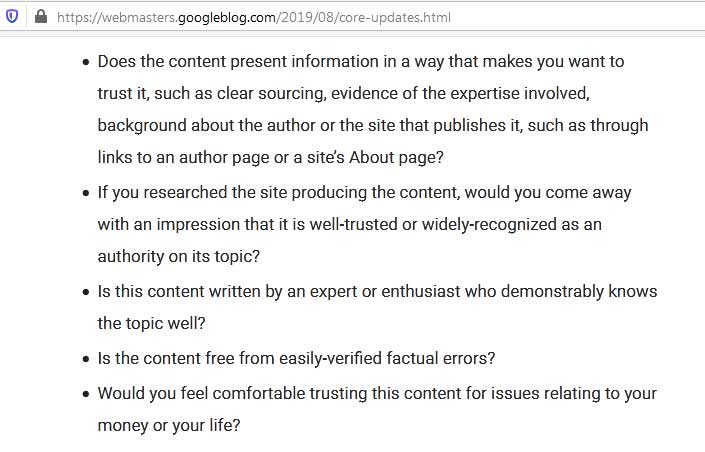
- Does the content present information in a way that makes you want to trust it, such as clear sourcing, evidence of the expertise involved, background about the author or the site that publishes it, such as through links to an author page or a site’s About page?
- If you researched the site producing the content, would you come away with an impression that it is well-trusted or widely-recognized as an authority on its topic?
- Is this content written by an expert or enthusiast who demonstrably knows the topic well?
- Is the content free from easily-verified factual errors?
- Would you feel comfortable trusting this content for issues relating to your money or your life?
Presentation and production questions
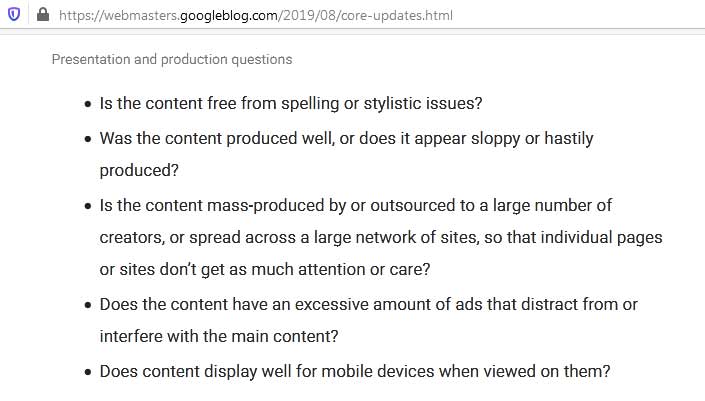
- Is the content free from spelling or stylistic issues?
- Was the content produced well, or does it appear sloppy or hastily produced?
- Is the content mass-produced by or outsourced to a large number of creators, or spread across a large network of sites, so that individual pages or sites don’t get as much attention or care?
- Does the content have an excessive amount of ads that distract from or interfere with the main content?
- Does content display well for mobile devices when viewed on them?
Comparative questions
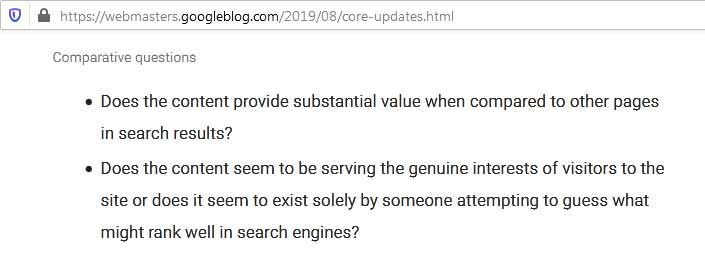
- Does the content provide substantial value when compared to other pages in search results?
- Does the content seem to be serving the genuine interests of visitors to the site or does it seem to exist solely by someone attempting to guess what might rank well in search engines?
Tips to Recover From Setbacks of January 2020 Core Update
If you are affected by the recent Google core algorithm update, then the fixes can be done by developing a structured content strategy and curating relevant content in accordance with the search intent of your targeted users. Below are the tips and suggestions to fix the issues and make your website more competent with the recent changes suggested by Google in its update –
- If you have lost the positions of your high-ranking pages, it is high time to compare them with the website that has either replaced you or on the top position. Check the quality of the content and other aspects they have implemented to rank a good position on Google.
- Before implementing any significant changes on the website on the SEO front, it is better to wait for some days. Sometimes, Google rolls back the changes. So, always keep your fingers crossed as your website might come back on the position on which it was before.
- Create content after extensive research on the selected topic to provide maximum information to the targeted users.
- Google has shifted its focus from search results based on keywords to topic-based results. It wants to enhance its SERP by providing users with detailed content that can fulfill their search intent.
- Always follow E-A-T Guidelines by Google
- Keep your focus on user intent and clean website architecture
Relevancy of Google E.A.T. Guidelines in January 2020 Core Update
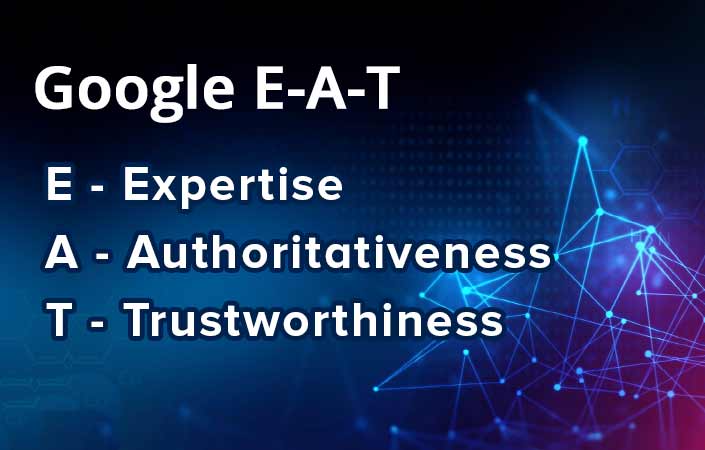
According to Google, E.A.T. Guidelines plays a significant role in all the algorithm updates rolled out by it as it focuses on the overall hygiene of the websites. This time too with January 2020 Core Update, the popular search engine will consider these guidelines to evaluate the ranking of the websites. The relevant E.A.T. guidelines stand for –
Expertise – The knowledge and expertise of the owner of the website or the author of the content on a particular subject. This factor becomes crucial for YMYL sites which provide information on medical subjects.
Authoritativeness – It is the credibility and authenticity of the website publishing the content including customer reviews, comments by readers, testimonials, or credentials.
Trustworthiness – The trustworthiness of the websites in terms of the site security and overall site quality.
It has been evident that Google has given priority to websites with high E.A.T. over the ones with low E.A.T. ever since Google E-A-T algorithm update was rolled out on August 1, 2018. These guidelines have been an active part of all the Google algorithm updates assisting the search engine giant in ranking websites. The E.A.T. guidelines aim at providing the best search results to the users for their search queries. Hence, it can be clearly judged that maintaining a website as per the rules and regulations of these guidelines can save you from the harsh impacts of the core algorithms updates in the future.
How to Implement Google E-A-T Guidelines?
Even after applying top-notch SEO tactics by publishing good-quality content, your website has been hit by the latest January 2020 Core Update. Ensuring that your website has E-A-T quality signals will help you surpass or recover from the current Google Algorithm update. Here is how you can implement these guidelines on your website and attain a good ranking on Google.
-
Include author profiles to all blog posts
Google Quality Guidelines clearly state that it is the right of the users to know the details of the person providing them the relevant information they are searching for. Make sure that all blog posts on the websites have author bios to have more transparency and show the reliability of the content to the users. The theme of the author bio must be configured in such a way that it is visible at the bottom of the posts as well as on top of the page. A lower bounce rate and longer engagement of users on the content page gives quality signals to Google about the author who has provided the information in a well-structured and detailed manner.Such guidelines have made it necessary for the websites engaged in the sale of products or services to give their contact information and also the details of customer support.
-
Reduce content with low E-A-T
As per the search quality guidelines of Google, E-A-T score of the website is assessed after summing up the total E-A-T score of individual pages or posts on a website. So, it is important to be vigilant about each and every post that gets published on the website. Removing the poor quality content from your website may lessen your traffic, but will eventually enhance the average E-A-T score of your website. - Optimization of “About Us” page
According to the Google guidelines, the information about the people who are running a website is a matter of significance for the users. Such information assists them in deciding whether they should trust the information available on the website or not. Therefore, to improve the E-A-T scorings and gain user trust, optimize or implement an “About Us” page on the website in accordance with the quality signals of expertise, authority, and trustworthiness such as –- Profiles of the team members with their experience and expertise
- Detailed company information including the business address and contact information
- Awards and entitlements of the Company
- Positive Press about the company
- Testimonials from clients and customers
- Add a schema mark up in the HTML code to give extra information to Google about your content.
Adhering to these guidelines will boost the trustworthiness of the visiting audience and impact the overall E-A-T score of your website.
- High-quality backlinks Relevancy of backlinks is another deciding factor for a good E.A.T. score. As per the Google E.A.T. guidelines, websites containing high-quality backlinks score better in E.A.T. assessment. Links which are not relevant or related to the current blog post or information add zero value to the website and can impact the E-A-T score negatively. Linking information with backlinks with related niche websites can improve the E-A-T score.
- Activeness on social media
Creating an official account on social media websites improvise the E-A-T score. Proactively sharing content on social media with the target audiences will improve the quality of the website. As the presence of the company on social media platforms builds a direct connection with the audiences, it can maintain a good reputation of the website among people. Though this may not directly impact the E-A-T, it will help you stay in the competitions and have more E-A-T quality signals. - Ensure site technical security with HTTPS
HTTPS stands for Hypertext Transfer Protocol Secure which ensures the security of the websites over the computer network. Security plays a major deciding factor to evaluate the E-A-T score of a website. As Google Chrome is listing all HTTP sites with a “Not secure” tag, it becomes essential to acquire an SSL certificate to have a good E-A-T score. Therefore, websites without this certificate and which fails to redirect to an HTTPS URL may face negative impacts of the algorithm update.
Guidelines by Google for Webmaster and SEOs
Understanding the impacts which this recent Google update has caused to multiple websites, the search engine giant has brought recommendations and guidelines for webmasters and SEOs to overcome the negative impacts of the Google Update.
“We suggest focusing on ensuring you’re offering the best content you can.”
When analyzing a website, Google suggests the technical experts to focus on the following four aspects:
Content & Quality: As the quality of the content posted on the websites play a significant role in their Google rankings, it is high time to work on this aspect and create more content as per the user intent. Below are some questions to check the quality of your content –
- Does the website provide good-quality content free from plagiarism?
- What is the page title and headline and do they reflect the idea behind the content?
- Does your content give a complete description of the topic?
Expertise: Trustworthiness of the website is a major factor that decides whether the user should stay or leave the website. The authenticity of the content and the page without errors are some factors focusing on which increases the chances to attain a ranking on Google.
Presentation & Production: A well-structured content with proper headings and sub-headings always appeal to the users. The content should be well-researched and well-produced and should not be the replica of the content published before. The presence of too many ads and pop-ups to increases the bounce rate of the website. Also, the page load time on several devices plays an important role.
Competitive comparison: Why would a user read the same piece of information on multiple websites? Innovation and that extra mile effort is what Google considers while allotting a good position to a website over others on its SERP. The website must offer added value to the users when compared with its competitors. Moreover, the content must fulfill the user intent giving answers to all the search queries.
The Ending Note
With the implementation of the January 2020 Google Broad Core Update, users can actually take a sigh of relief as only websites with high-quality content will be visible on the first page. They can easily trust the quality of the content published on those websites as they have been audited by Google in relation to the recent update. The update is like a jolt of lightning for the websites which have been copying content from other websites or not taking updates of Google seriously.
Losing the ranking on Google after the rolling out of the January 2020 update doesn’t mean that your website is bad or penalized, but the update urges you to work on the overall quality of your website. It is just an analysis of the websites and rewarding them a Google position based on the efforts they have applied in following the guidelines issued from time to time.
